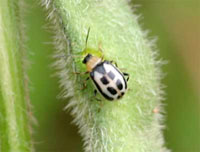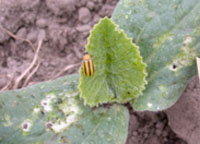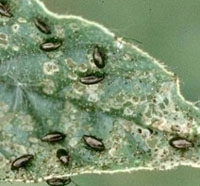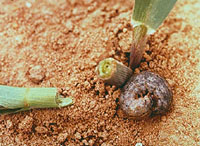"We are what we repeatedly do. Excellence, then, is not an act, but a habit." --Aristotle
Address any questions or comments regarding this newsletter to the individual authors listed after each article or to its editor, Rick Weinzierl, 217-333-6651, weinzier@illinois.edu. To receive e-mail notification of new postings of this newsletter, call or write the same number or address.
In This Issue:
Regional Updates (from southern, western, and northern IL)
Notes from Chris Doll (early flowering and cold injury reports and ways to reduce losses)
Local Foods Issues (IL SARE sites)
For Fruit and Vegetable Growers (new fungicide -- Fontelis)
Fruit Production and Pest Management (oriental fruit moth, codling moth, peach borers, northern IL grape report)
Vegetable Production and Pest Management (aphids in high tunnels, soon-to-come insects)
Upcoming Programs
- Sustainable Beekeeping Practices and Backyard Queen Rearing, May 5, 2012. University of Illinois Extension, Sangamon County Extension Office, 700 S. Airport Drive, Springfield. Register at https://webs.extension.uiuc.edu/registration/?RegistrationID=6605 or contact Deborah Cavanaugh-Grant at cvnghgrn@illinois.edu or call 217-782-4617.
- High Tunnel Workshop, May 12, 2012. Workforce Careers Center, Lincoln Land Community College, 9:00 a.m. to 4:30 p.m. Mike Bollinger will cover siting considerations, pre-planning, and construction of a high tunnel. Participants will assist in constructing a 22x48 high tunnel during the workshop. Registration is $30. (A discounted rate of $50 will be charged to participants who sign up for this and the June 11 workshop listed below.) Registration includes a box lunch and copies of two books, The Polytunnel Handbook and The Winter Harvest Handbook. For more information and to register, see www.llcc.edu/greencenter or contact Julie Bates at julie.bates@llcc.edu or 217.786.2434. Hosted in conjunction with University of Illinois Extension and funded with the assistance of the Illinois Community College Board and the Illinois Department of Commerce and Economic Opportunity.
- Equipment for Small Farmers, Soil Fertility and More (Central Illinois Sustainable Farming Network Workshop), May 12, 2012. Spence Farm, Fairbury, IL, 10:00 am to 3:00 pm. Register at https://webs.extension.uiuc.edu/registration/?RegistrationID=6646 or contact Deborah Cavanaugh-Grant at cvnghgrn@illinois.edu or call 217-782-4617.
- SW Illinois Orchard Twilight Meeting, May 24, 2012. Eckert’s Grafton Farm, 20995 Eckert Orchard Lane, Grafton, IL. Program begins at 6:00 p.m. For more information contact Andrew Holsinger at 217-532-3941 or aholsing@illinois.edu.
- High Tunnel Workshop, June 11, 2012. Workforce Careers Center, Lincoln Land Community College, 9:00 a.m. to 4:30 p.m. Mike Bollinger and local growers will cover developing a planting plan, planting, and management topics including insect and weed control and winter growing. Registration is $30. (A discounted rate of $50 will be charged to participants who sign up for this and the May 12 workshop listed above.) Registration includes a box lunch and copies of two books, The Polytunnel Handbook and The Winter Harvest Handbook. For more information and to register, see www.llcc.edu/greencenter or contact Julie Bates at julie.bates@llcc.edu or 217.786.2434. Hosted in conjunction with University of Illinois Extension and funded with the assistance of the Illinois Community College Board and the Illinois Department of Commerce and Economic Opportunity.
- Illinois Summer Horticulture Day, June 14, 2012, at Kuipers Family Farm near Maple Park, Illinois. More details in upcoming issues of this newsletter.
Regional Updates
In southern Illinois … Despite freeze alerts statewide, much of the southern region (south of I-70) stayed above freezing through Wednesday morning. The eastern side of the region ran closer to freezing, and many strawberry growers covered strawberries or ran frost irrigation through the event to protect sensitive flowers – the fruit can tolerate short windows of below-freezing temperatures (~28 F). The cold pocket that dips down through Marion and northern Jefferson counties reported the coldest temperatures in the region, with one grower reporting a low of 23.5 F at ground level and noticeable damage to strawberry flowers.
With the season so far ahead, it was not uncommon this year for apple and peach growers to have started their spray programs while still finishing up dormant pruning. Apple and peach are into cover sprays; see Rick’s comments on accelerating the peach trunk spray schedule for borer control. The apple and peach crop looks to be full for the most part, with most growers having 1-2 thinning sprays on apples.
Grapes are anywhere from bud break to 10” shoots. Several growers have noted adult grape flea beetle presence and resulting damage to buds and early emerging leaves. See the 2012 Midwest Small Fruit and Grape Spray Guide for the most current recommendations for control (http://www.ag.purdue.edu/hla/Hort/Documents/ID-169-2012.pdf). Raspberries, blackberries and blueberries are leafed out. The crop looks to be good for apricots and cherries, though trees are not abundant in the region.
The earliest sweet corn planting date reported to me so far was March 10th. Barring injury from frost, this year sweet corn should be on the market well before the Fourth of July target date. Tomatoes in high tunnels are buttoned up through the cold spell but in general are still ahead of schedule with the previous unseasonably warm weather.
Elizabeth Wahle (618-344-4230; wahle@illinois.edu)
In the Galesburg area … Twenty-seven degrees in the early morning on April 11 in western Illinois. Sensitive plants were looking tough this morning. More cold-hardy vegetable crops seemed to survive unscathed. Most were transplants with row covers used this last week. Colder temperatures (26-31 degrees F) may burn foliage but will likely not kill the chard, lettuce, mustard, onion, radish, and turnips that have been planted.
High tunnels in the area are full of early season lettuce varieties and assorted greens which are growing quite well. Aphids continue to be a significant issue for high tunnel producers.
Sweet corn planting has begun on some farms. Soil temperature at 4 inches is 49.9 degrees. With these temps, direct seeded crops have a long way to go to get to a suitable germination temp.
Kyle Cecil (309-342-5108; cecil@illinois.edu)
In northern Illinois, like much of the state, conditions have been suitable for outdoor work, even planting, for weeks, but the events of April 9-12 show why second-guessing the calendar can be treacherous. While we were so warm in March and early April, more normal temperatures moved in, with lows dropping to the mid-20s on April 11. Most fruit crops are very exposed, with apples in full bloom and grapes with 2-4” shoots. While it’s a little early to assess the damage from this freeze, it is clear there’ll be damage across the industry.
For those growing sweet corn, it may have been tempting to get those first plantings in the ground, and some have. The urgency was driven partly by dry conditions in the top 2-3” of soil. We’re at only about 50% normal precipitation for the year, and though last fall provided some good soil moisture, the warm conditions in March certainly drove some of the moisture out. With this cold wave, we now see soil temperatures at 4” down around 40oF, a little cold for sweet corn, especially the varieties with the sh2 gene for enhanced sweetness. Temperatures around 55oF in the seed zone are important for good germination rates and uniform emergence with those cultivars. This may be a good spring to use early varieties that may not have the best flavor profiles but that can be depended on for good germination. Onions, cole crops, and early greens and root crops are also being planted now.
Weeds have certainly jumped out to a good start. Winter annuals are far along, and many are flowering and developing seed. Those seeds may be building up soil seed banks this spring if not addressed. Many annual weeds have started very early, with the earlier warm temperatures favoring germination. Lambsquarter is at 2” in many fields, creating a blanket of vegetation. Preparatory tillage will need to be thorough this year to prevent escapes, particularly if they get more size and develop woody structures.
Transplants in the greenhouse are generally well along in development, with summer vegetables such as tomatoes and peppers up in trays and advancing toward maturity. The sunny spring so far has pushed transplant crop development a little further ahead of schedule.
For those with high tunnels, it’s time to start getting warm-season crops, such as tomatoes, in the ground. In past research at St Charles, we found consistent results from planting tomatoes by April 20. Planting by April 10 was a little riskier with low temperatures more likely to reach below 25oF. At such temperatures the tunnel begins to become vulnerable, depending on the site and tunnel size. Row covers over the crops can help considerably, so have them available or use them to push a quicker star for your transplants.
Will this be a dry season? The last 4 seasons have all been wetter than normal in northern Illinois, especially in May and June. This led to a slower start to the season, slower crop development, and more disease. Let’s have the irrigation ready this year!
Bill Shoemaker (630-584-7254; wshoemak@illinois.edu)
Notes from Chris Doll
A fruit grower friend once told me that he had no qualms about a yearly trip to the casinos because he was gambling on the weather for most of the year anyway. This week brought this to mind as the April 11 morning temperature of 33.4 in the Back-40 had to cause lots of concern by many fruit growers with their choice of gambling on this occupation. So, I lucked out with not even a frosted strawberry blossom and figure the tree fruits are all OK. Other reports may not be so good, especially as one goes north. Grapes and strawberries were the primary concern about frost in this area because the tree fruits are well into fruit set time. Shucks are off of all stone fruits and apples are in prime thinning size at the time of the very cool daytime temps to cause concerns about optimum thinning conditions for some. Earlier thinning applications were made into late bloom and very early petal fall by a few growers during warm weather earlier, and the results look good.
I was called a 'historian' by a friend last week and so went to the record book of April 12, 1973, where a temperature of 24 degrees was recorded. Peaches were in full bloom in the area that year, and lots of damage was seen. It was memorable, because I was called by a peach grower asking about using a liquid fertilizer as an anti-freeze. My request was for some unsprayed check trees, which were the lowest trees in the orchard. The result was that the coldest part of the orchard was the check area with a frozen crop and the sprayed trees going up the slope survived because of the temperature gradient.
With the record early flowering and fruit set in many areas, there were numerous questions about how to delay flower bud development. Elizabeth Wahle called me for input, of which I had very little, and nothing where the development was so well advanced. I had followed the testing of ethephon on peaches as a fall application to delay bloom for a few days, but in this area it did not meet grower needs over the years. Dr. Brad Taylor of Southern Illinois University tried late dormant applications of soybean oil at several rates. There was a slight delay in bloom and some significant tissue injury at high rates. Maximum delay was 6 days with the injury; otherwise about 4 days’ delay occurred. The application timing for both of these treatments is so far in advance of the emergency date that their use and cost appears to be a too much of a gamble.
Other discussions this spring were about prevention of frost/freeze injury. The use of helicopters, fans, heat, and sprinkling with water have been around for years, and the problems of investment, availability, and expense make them problematic for most growers. So, usually it goes back to how to decrease the potential problem. And the answers are not new. To summarize, the list goes like this:
- Good site selection
- Provide cold air drainage (TV coverage showed a Missouri grape grower sawing trees from a valley to allow air drainage)
- Correct plant/variety selection, which does not help much, but for which a late bloomer such as Rome apples have been mentioned
- Avoiding soil cultivation to avoid having a drier soil surface for faster heat radiation
- Mowing or removing cover crops for the same reason for faster heat loss.
Codling moth biofixes have been set by local growers, and oriental fruit moth is in the same category. Some curculio injury can be found in lesser sprayed trees, but otherwise it has been a quiet spring. Likewise, disease infections have been minimal.
Chris Doll
Local Foods Issues
A quick reminder that a major initiative of the Illinois Sustainable Agriculture Research and Education (SARE) program is scaling up local food systems. Information is available at:
- The Illinois SARE website: http://illinoissare.org/
- The Illinois SARE Facebook page: https://www.facebook.com/ILSARE
- The Illinois SARE Twitter account: https://twitter.com/#!/IllinoisSARE
Mary Hosier (217-333-7512; mhosier@illinois.edu)
For Fruit and Vegetable Growers
New Fungicide for Vegetables and Fruit Crops
Fontelis 1.67SC (20.4% penthiopyrad) is a newly-registered fungicide for control of diseases of some vegetable and fruit crops and is now available for use in Illinois. Fontelis, manufactured by DuPont Company, is a broad-spectrum fungicide, recommended for control of foliar and soil-borne plant diseases, and has preventive, curative, and locally systemic activities. Fontelis can be used for control of diseases of Brassica crops (broccoli, cabbage, cauliflower, kale, etc.) bulb vegetables (onion, garlic, and chives), cucurbits (cucumber, melon, pumpkin, squash, etc.), fruiting vegetables (eggplant, pepper, tomatillo, and tomato), leafy vegetables (lettuce, celery, and spinach), legume vegetables (beans and peas), root vegetables (beets, carrots, horseradish, etc.), pome fruits (apple and pear), stone fruits (cherry, nectarine, peach, and plum), strawberries, and blueberries. The pre-harvest interval (PHI) of this fungicide is 0-3 days on vegetable crops and 0-28 days on fruit crops (see label). Results of field testing in Illinois showed that Fontelis was among the most effective fungicides for control of powdery mildew of cucurbits and spring diseases (scab, powdery mildew, rust) of apple. For more information on Fontelis 1.67SC, see http://www.cdms.net/LDat/ldAHH000.pdf.
Mohammad Babadoost (217-333-1523; babadoos@illinois.edu)
Fruit Production and Pest Management
Oriental Fruit Moth, Codling Moth, and Lesser Peachtree Borer
The Illinois Degree-Day Calculator site is not available this spring pending updates to revise it. If you are trapping for codling moth and oriental fruit moth, please email me or call me with reports of biofix dates (first sustained captures of moths in traps) for your location … I'll use your information and the Midwestern Climate Center database to provide updates on degree-day accumulations for these insects throughout the state in upcoming issues of this newsletter.
Degree-day "look-up tables": For growers who are using traps for oriental fruit moth and codling moth but do not have weather-monitoring stations with programs that calculate degree-days, using local weather stations' minimum and maximum daily temperatures is an option for approximating degree-day accumulations. Tables that allow you to look up degree-days for these insects based on min-max temps are available at http://jenny.tfrec.wsu.edu/opm/displaySpecies.php?pn=-55. Add each day's degree-day accumulation since biofix to keep track of totals.
Oriental fruit biofix for Urbana was March 24; for at least some orchards in southern to southwestern IL, the biofix date (beginning of consistent flight) was March 18. Based on a 45-degree F developmental threshold, degree-day accumulations through April 10 were approximately:
Location |
Biofix Date |
Degree-days (base 45F) |
Carbondale |
March 18 |
511 |
Belleville |
March 18 |
497 |
Urbana |
March 24 |
234 |
First generation egg hatch ends (or declines to very low levels) by about 650 degree-days after biofix, and second-generation flight begins about 950 degree-days after first generation biofix. The previous issue of this newsletter noted that it was time to begin insecticide applications for oriental fruit moth if needed for prevention of first generation larval development in peach shoots. Ideal timing for a first treatment is at 170-195 degree-days after biofix (when 10-15 percent of eggs have hatched. If needed, a second spray should be applied at 350-375 degree-days (55-60 percent egg hatch) … these time frames have now passed in southern IL. For growers who are using mating disruption for oriental fruit moth control, it is essential that dispensers be in place before second generation flight begins at around 950 degree-days … second-generation larvae infest fruits of peaches and other stone fruits. For additional background information on oriental fruit moth, see http://agsci.psu.edu/tfpg/part2/insects-mites-web/oriental-fruit-moth.
Codling moth flight is underway in southern Illinois, but traps in orchards at Urbana and the Peoria area have yet to capture any moths. The ideal timing of insecticide applications for codling moth control varies for different insecticides, depending on whether their primary toxicity is to eggs or larvae. Rimon's label recommends application at 50-75 degree-days (base 50F) after biofix; labels for Altacor, Assail, Calypso, and Belay recommend application by 150-250 degree-days after biofix; and Guthion and Imidan have always been applied by 250 degree-days after biofix. Egg hatch (with larval entry into fruit very soon after egg hatch) begins about 240 degree-days after biofix.
Lesser peachtree borer flight usually begins in early May in southern Illinois, but the warm spring will likely mean that flight will begin very soon. Mating disruption dispensers (Isomate PTBD … peach tree borer dual) are available and effective for control of lesser peachtree borer and (greater) peachtree borer. If mating disruption is to be used for borer control, dispensers should be applied in the next 10-14 days in the southern half of the state. Great lakes IPM in Michigan is a regional supplier of these dispensers. Trunk sprays of Lorsban 4EC are very effective against lesser peachtree borer, and pyrethroids such as Asana, Warrior, Pounce, and Baythroid are also labeled for this use. Lorsban sprays must be directed at the trunk and NOT contact fruit. For a listing of rates for these products, see the 2012 Midwest Tree Fruit Spray Guide.
Rick Weinzierl (217-244-2126; weinzier@illinois.edu)
Northern Illinois Grape Crop Report
The early warm weather in March has led to early budbreak in our hybrid grape varieties. Because many of them are based heavily on Vitis riparia genetics, they tend to break bud early in a normal season. This year they have been way ahead of schedule, leading to risk from freezing temperatures.
Those freezing temperatures arrived the second week of April, with temperatures down to 26oF in many places, particularly in northeastern Illinois. This is a good time to evaluate your choice of site for planting grapes to see if the site provided some level of escape from the colder temperatures around you. Even if you still had some damage, you may have escaped worse damage because of the elevation of your site. This effect can be seen even within a vineyard block. Look especially at the low end of trunks where adventitious buds may have opened. It isn't uncommon to see damage on the lower 2-3' of the trunk, but none up on the cordon in High-Cordon systems.
Did anyone escape damage by using techniques to delay budbreak? I have not heard reports, nor did I have any treatments set up to test these techniques. I'll suffer like most. But if anyone used long-spur pruning or oil sprays to delay count-bud break, I would be interested in hearing from you whether it was successful or not. It could be that we were just too far along with the season for these techniques to pay off.
Once damage occurs, what are the implications? The primary buds break out first in grapes and they are the strongest, most productive buds among the compound buds found on last year's growth. That is why we use them as count-buds. We count on them to provide the productivity in this year's crop because they carry the most potential. If they are damaged by a freeze, we lose the most productive buds on our vines and some of the crop potential we were looking for in our vineyards. Fortunately, because grapes have compound buds, they will shoot new buds to replace damaged ones. These will mostly be secondary buds, though if secondary buds were already broken out in places, tertiary buds may begin to open as well. In hybrid varieties, secondary buds can be productive, though they are not as productive as primary buds. A crop from secondary buds may be only 40-50% of the crop from primary buds. Tertiary buds are often unproductive, though it isn't uncommon to find clusters on shoots from tertiary buds. But those clusters are often much smaller. They probably will only contribute marginally to the total crop. The bottom line is that the crop will be reduced, though the management demand will not. It may take even better management to reach this crop's potential and keep the vines in good condition for next season.
Another consequence of having significant freeze damage is that the damage is variable. While most primary shoots are damaged, some may survive. These shoots will be much more advanced than the subsequent secondary shoots which emerge. That means the clusters will ripen unevenly once they begin to mature, with the primary shoots ripening fruit first. This can be difficult for the grower to handle. Should you save every good cluster to make the most from an already reduced crop? Should you eliminate the primary clusters to focus the plant's energy on a uniform crop from secondaries? If primary shoot clusters are saved, can they be harvested first, with the secondaries harvested later? This may be a decision that should be shared with the winemaker, with the cost to each shared. At any rate, this situation can impact the quality of harvest if not addressed early. Make sure you and your winemaker are happy with your decision.
The vine itself may suffer from the impact of these kinds of freeze events. Shoots that are frozen off, especially if from secondary buds, may be replaced by weaker tertiary shoots, or not at all. It isn't unusual to see blind spots develop on cordons due to these kinds of events. This is a key time to focus on the vines and cordon development. If cordons needed replacing before, this is a great time to address that problem. Make sure the vines are well-fed and watered to push growth where such growth is needed. Spend the time to make sure shoots are properly positioned structurally for next year's crop. Don't neglect canopy management because there isn't as much crop. The quality and crop potential for next season will depend on your canopy management practices this year, even if the crop you wanted isn't there this season. Optimizing light into the canopy will improve the quality of buds on production canes or spurs next season, so make sure shoot thinning and positioning are done well. Remove laterals where needed to keep soft light moving into the fruit zone, where next year's crop is in development.
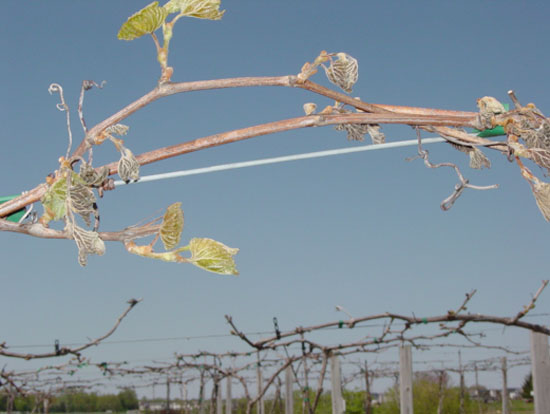
Freeze damage to vines in 2011.
Seasons like this show how fruit producers, grape growers included, are people of character. It takes strong character to weather the challenges. But persistence and patience can pay off with quality crops, even in a down year. Keep watching this newsletter to keep updated on this year's vineyard developments.
Bill Shoemaker (630-584-7254; wshoemak@illinois.edu)
Vegetable Production and Pest Management
Aphid control in greens in high tunnels
As Kyle Cecil noted in his report from the Galesburg area, aphids are common on leafy greens in high tunnels. The options for control vary a little depending on whether the greens are lettuce, herbs, and spinach or Brassica greens such as collards, kale, etc.
For lettuce and spinach (and many herbs), older insecticides such as Malathion and Diazinon are somewhat effective, but preharvest intervals (PHIs) for Malathion are 14 days for leaf lettuce and 7 days for spinach, and the PHI for Diazinon is 14 days ... making their use impractical in many instances. Insecticides that are more specific for aphid control include Actara (7-day PHI), Assail (7-day PHI), Fulfill (7-day PHI), Movento (3-day PHI), and Provado (7-day PHI) ... again, the PHIs for most of these are long enough that growers need to monitor infestations well in advance of harvest and plan/treat accordingly. Additionally, these specific aphicides are fairly expensive, and where they are sold only in large containers or case volumes, the cost may be prohibitive for growers with a couple of high tunnels. M-Pede (and other insecticidal soaps) and Neemix (and other formulations of azadirachtin) can be used in organic production and by conventional growers ... each can be used up to the day of harvest. Thorough coverage is essential for effective control of aphids on leafy greens.
For collards, kale, and related greens, Diazinon is not labeled for foliar application. Otherwise, the list is similar to the text above for lettuce and spinach. See the 2012 Midwest Vegetable Production Guide for PHIs on these crops and for rates and restrictions.
For all of these crops, pyrethroids (Asana, Baythroid, Brigade, Mustang Max, and Warrior – and generic products with the same active ingredients) and natural pyrethrins (Pyganic and similar formulations) are NOT effective against aphids. They generally wipe out natural enemies and trigger increased problems with aphids.
Rick Weinzierl (217-244-2126; weinzier@illinois.edu)
As early-planted crops begin to emerge, be on the lookout for ...
Bean leaf beetle |
|
... on beans, in particular. Adults have overwintered and will move to beans as they emerge. If defoliation stunts seedlings, foliar insecticides may be needed. |
Striped cucumber beetle |
|
... on cucumbers, melons, and squash. These beetles are especially destructive to cucumbers and muskmelons because these crops are susceptible to bacterial wilt caused by a pathogen that striped cucumber beetles transmit to plants when they feed. Farmore™-treated seed (applied by the seed company) provides systemic control for 2 weeks or so after emergence. Several insecticides are effective as foliar sprays; retreating is often necessary as new foliage emerges and expands on rapidly growing plants. |
Flea beetles |
|
... on sweet corn, cole crops, leafy greens, potatoes, and several other crops. Different species infest different crops, but all overwinter as adults and move to young plants as they emerge or when transplants are set. Tiny beetles eat holes in leaves and jump when disturbed (and they can fly as well). Corn flea beetles transmit Stewart's wilt ... this disease causes serious losses in susceptible sweet corn varieties. |
Cutworms |
|
... especially black cutworm on corn but also other cutworm species on a variety of vegetable crops. Black cutworm moth migration from the south has been significant in several areas of Illinois already this spring. |
For all of these insects, see the 2012 Midwest Vegetable Production Guide for listings of insecticides and rates for specific crops. Where the scale of production and availability of labor allow, using row covers to exclude bean leaf beetles, cucumber beetles, and flea beetles is also an option on young plants.
Rick Weinzierl (217-244-2126; weinzier@illinois.edu)
Less Seriously ...
Remember, although the magical date has passed again for another spring, it's always April Fool's Day in Congress.
University of Illinois Extension Specialists in Fruit and Vegetable Production & Pest Management
Extension Educators – Local Food Systems and Small Farms |
||
Bronwyn Aly, Gallatin, Hamilton, Hardin, Pope, Saline, and White counties |
618-382-2662 |
|
Katie Bell, Franklin, Jackson, Perry, Randolph, & Williamson counties |
618-687-1727 |
|
Sarah Farley, Lake & McHenry counties |
847-223-8627 |
|
Nick Frillman, Woodford, Livingston, & McLean counties |
309-663-8306 |
|
Laurie George, Bond, Clinton, Jefferson, Marion, & Washington counties |
618-548-1446 |
|
Zachary Grant, Cook County | 708-679-6889 | |
Doug Gucker, DeWitt, Macon, and Piatt counties |
217-877-6042 |
|
Erin Harper, Champaign, Ford, Iroquois, and Vermillion counties |
217-333-7672 |
|
Grace Margherio, Jackie Joyner-Kersee Center, St. Clair County |
217-244-3547 |
|
Grant McCarty, Jo Daviess, Stephenson, and Winnebago counties |
815-235-4125 |
|
Katie Parker, Adams, Brown, Hancock, Pike and Schuyler counties |
217-223-8380 |
|
Kathryn Pereira, Cook County |
773-233-2900 |
|
James Theuri, Grundy, Kankakee, and Will counties |
815-933-8337 |
|
Extension Educators – Horticulture |
||
Chris Enroth, Henderson, Knox, McDonough, and Warren counties |
309-837-3939 |
|
Richard Hentschel, DuPage, Kane, and Kendall counties |
630-584-6166 |
|
Andrew Holsinger, Christian, Jersey, Macoupin, & Montgomery counties |
217-532-3941 |
|
Extension Educators - Commercial Agriculture |
||
Elizabeth Wahle, Fruit & Vegetable Production |
618-344-4230 |
|
Nathan Johanning, Madison, Monroe & St. Clair counties |
618-939-3434 |
|
Campus-based Extension Specialists |
||
Kacie Athey, Entomology |
217-244-9916 |
|
Mohammad Babadoost, Plant Pathology |
217-333-1523 |
|
